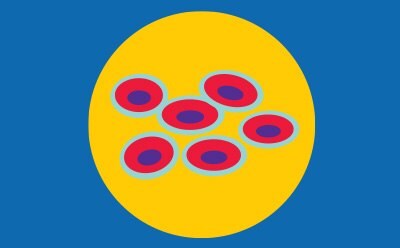The Researcher’s Guide to Designing CRISPR and RNAi Screening Experiments
CRISPR and RNAi are two screening tools you can use to study gene function by modulating gene expression and observing the outcomes. While CRISPR does this at the transcriptional level by binding DNA, RNAi binds mRNA and blocks translation, typically by degrading mRNA. Despite the differing mechanisms, both methods follow similar workflows. This guide will help you think through some of the questions involved in designing your screening experiment.
Step 1: Choose a cell line for your screen

You’ll need to identify which cell lines will work for your experimental requirements. First, consider the biology and ask yourself whether the cell line can closely model the biological process you’re studying. Choose the one that best recapitulates your model organism or disease of study. Some of the different types of cell you could use include:
- Primary cells. Primary cells are harvested directly from mammalian tissue. They have a limited lifespan, but can more accurately represent in vivo biological mechanisms. Because they can be taken from donor tissues, primary cells allow you to consider factors such as age, sex, and medical history in the context of your study.
- Immortalized cell lines. Immortalized cell lines can be propagated indefinitely as a result of intentionally-introduced mutations that allow them to continually replicate. Because of their continuous propagation, these cells often have genotypic and phenotypic variations that could confound findings.
- Induced pluripotent stem cells (iPSCs). iPSCs can be used when an immortalized cell line is not the best representation of your cell type or your disease of interest. Since iPSCs can differentiate into many cell types, they may be suited for many areas of study.
In choosing a cell line, you might need to balance a cell line that is biologically appropriate with its ability to be adapted to your workflow and experimental parameters. For example, immortalized cell lines are often easier to use, with documented and published methods available, but might not be the most accurate biological representation of what you are studying. You may also consider practical aspects such as the doubling time of your cells and the ploidy of the cell line that can affect their ease of use and the time it takes to get results.
Step 2: Design or choose your gRNA or shRNA library and screening strategy

CRISPR and RNAi libraries typically contain thousands of plasmids and multiple gRNAs or shRNAs for each target gene. For any experiment, it is important to target multiple sites per gene to increase confidence in your results, as different gRNAs and shRNAs can have varying off-target effects.
Another key consideration is scale: you might choose a library that targets the whole genome, or one that focuses on a subset of sequences. For example, MISSION® shRNA collections are available as libraries that are relevant to specific pathways or that target gene families like phosphatase or kinases.
You also need to decide whether to use a pooled or arrayed approach, each of which has its pros and cons. A pooled library maximizes the number of gRNAs/shRNAs per gene target, while an arrayed library optimizes gRNA/shRNA design. To analyse the data you get from the screen, a pooled library requires next-generation sequencing while interpreting results from an arrayed library is more straightforward. In terms of delivery, pooled libraries must be delivered via lentivirus, and arrayed libraries offer more flexibility. More information about the practical differences between pooled and arrayed libraries can be found in Step 5.
As with any experiment, your screen should have the appropriate controls. Use non-targeting guides and shRNAs, and consider controls for enrichment/depletion depending on your screening approach. If you’re designing your own library, spread out the target location of gRNA/shRNA controls to avoid potentially clustering them in inaccessible genomic regions.
Step 3: Determine optimal conditions for your screen

Before introducing the library to the cells, it is necessary to conduct a series of experiments to identify optimal conditions for transduction or transfection. This is key because low efficiency can result in insufficient representation of the library in the modified cell population, but efficiency too high could mean a single cell expresses multiple gRNAs/shRNAs, making it difficult to interpret results. Ideally, you want to strike a balance such that your final pool of cells expresses one gRNA/shRNA. For lentivirus, this means a multiplicity of infection (MOI) between 0.4 and 0.6 transducing units per cell1. To find the appropriate MOI, you can use a colony forming unit assay based on antibiotic resistance or a fluorescent marker to determine the functional titer.
Since not all cells will be transduced, you will need to select for cells that have taken up the gRNA or shRNA with the appropriate concentration of antibiotic. A kill curve can determine the concentration of selection antibiotic needed to effectively deplete untransfected or untransduced cells. Using an antibiotic concentration too low results in the growth of untransfected cells, which would confound any results obtained from the screen.
Step 4: Evaluate your Cas9 expression source

Note that this step is only relevant for CRISPR screening and not RNAi screening.
Any CRISPR experiment requires target cells to be provided with both gRNA and Cas9 protein. To accomplish this, you will either need to establish a Cas9-expressing cell line that you will deliver gRNA to, or provide in an “all-in-one” vector to your cells that provides both the Cas protein and the gRNA in one construct (e.g. the GeCKO2 Mouse Whole Genome Pooled Library).
If you use Cas9-expressing cell lines, you can choose to perform clonal isolation or use the mixed population of Cas9-expressing cells for screening. Some additional considerations for choosing the optimal Cas9 source include: verifying that there is constant expression of Cas9, eliminating concerns about co-transduction of gRNAs, and ensuring that the Cas9 source can support high-throughput sgRNA applications.
Step 5: Perform your screen

Now it’s time to perform your screen! Workflows for pooled and arrayed screens are overall similar, but have some differences:2
- Library preparation. Pooled libraries contain thousands of gRNAs / shRNAs per tube while arrayed libraries have one gRNA / shRNA per well.
- Library delivery. Pooled libraries are generally delivered via lentivirus while arrayed libraries can be delivered in many formats (e.g. plasmid or viral expression vectors, synthetic oligonucleotide). 3
- Screen duration. Pooled libraries are efficient for genome-wide screening while arrayed libraries will require more time with increasing number of clones.
- Screen capability. For in vivo screening, use pooled libraries. Arrayed libraries cannot support this.
- Analysis. Pooled library screens are analyzed using deep sequencing, and deconvolution is required to analyze the data and identify hits. For arrayed screens, NGS is not required.
- Readout. Pooled library screens have limited readouts (i.e. cell death or proliferation), but can be coupled with single cell analysis. On the other hand, arrayed libraries have multiple options for readouts including fluorescence, luminescence, high-content microscopy, or live cell imaging.
This guide covers the basic considerations to begin planning your screening experiment. The printable infographics summarizing this article can be found below. For help selecting a screen or any other questions, connect with a scientist.
References
계속 읽으시려면 로그인하거나 계정을 생성하세요.
계정이 없으십니까?